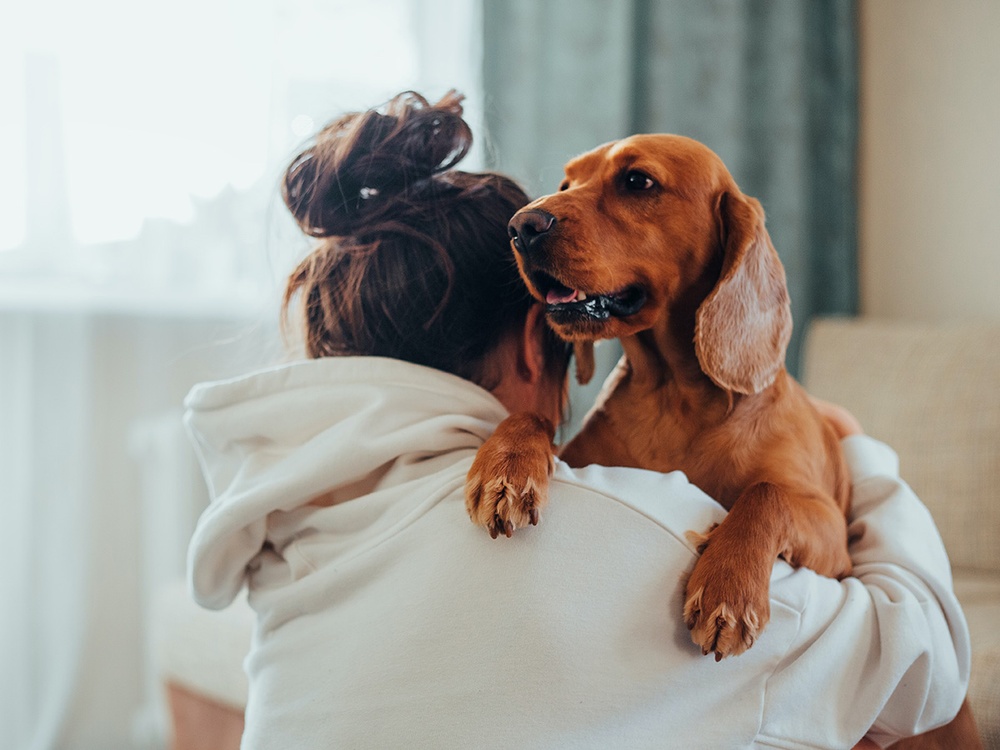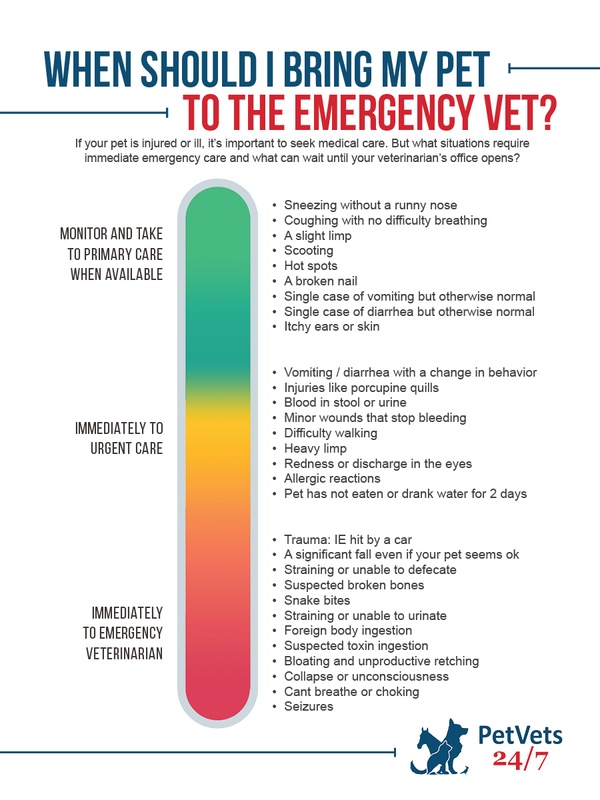When Should I Bring My Pet To The Emergency Vet?
It’s Sunday evening when you suddenly notice your pet is having some health issues, or now that you think of it, they really haven’t been themselves all day. Pet health emergencies can happen at any moment. Unfortunately, they somehow tend to happen outside of your veterinarian’s normal office hours.
If your pet is injured or experiencing an illness, it is important to seek medical care. The question is, what situations require an immediate trip to the emergency vet hospital and what conditions can wait until Monday morning when your veterinarian's office opens?
What Are Common Veterinary Emergencies For Pets?
There are endless ways our pets may end up needing medical care. A scuffle with the neighborhood raccoon troop, a weekend bout of tummy troubles, and even that lone sock that never makes it quite into the hamper can become a source of a medical situation.
As a pet parent, the last thing you want to think about is your pet suffering a health emergency. But the truth is that one in three pets will need emergency veterinary care every year. While the types of medical emergencies are vast, knowing your pet and common signs of distress can be a life-saving skill. Common pet health emergencies include:
1. Trauma
All trauma requires urgent veterinary care. Some common traumas include: a pet being hit by a car, being in a car accident, falling from a significant height, gunshot wounds, being attacked by another animal, cuts that won’t stop bleeding, suspected fractured limbs, dragging limbs, or inability to use a limb. Any bleeding that is substantial, pulsing, or lasts more than five minutes must be seen quickly by a veterinarian.
2. Collapse, weakness, or becoming non-responsive
Pets that are non-responsive or becoming progressively less responsive, collapse, are unresponsive, or cannot be roused from sleep are all experiencing a health emergency that requires quick medical intervention.
3. Difficulty Breathing
Just three minutes without air is enough to end a pet’s life. If you notice your pet struggling to breathe, making strange noises while breathing, breathing abnormally, or especially if your pet has known respiratory or heart issues, take immediate action.
4. Toxins
Poisoning of any sort is an emergency. Ingestion or suspected ingestion of cleaners, chemicals, or medications, eating poisoned rodents, snake or spider bites, or common foods like chocolates, grapes, artificial sweeteners, and other human foods toxic to pets (link) all warrant quick action.
Common signs of poisoning vary greatly but include frothing at the mouth, drooling, vomiting, diarrhea, lethargy or an unsteady gait, heavy breathing, sudden bouts of vomiting, and seizures. Do not wait for your pet to show symptoms if you suspect they have ingested a toxin. If you suspect poisoning, contact Poison Control immediately; you can call the ASPCA Pet Poison Control (888) 426-4435 or the Pet Poison Helpline (855) 764-7661. Both are available 24/7. If you can, bring the suspected poison with you to the veterinary hospital for more efficient treatment.
5. Digestive Problems
Sudden or extreme changes in your pet’s appetite, bowel movements, or digestion are a strong sign that something is wrong. Call the emergency hospital if your pet is experiencing sudden or extreme vomiting (especially if your pet is unable to keep water down), vomiting blood, has sudden or extreme diarrhea (especially if the diarrhea is pure blood or dark and tarry), or has ingested an object (socks, string, toys, etc).
6. Inability To Urinate
Being unable to pass urine is always a life-threatening situation. This condition may be caused by bladder inflammation, infections, cancer, urinary stones, or even kidney failure. Without immediate action, your pet may experience severe pain, kidney injury, bladder rupture, and even death.
7. Refusing food and water
Regular food and water intake are integral to healthy pets. Skipping a meal is not unusual for some dogs. However, a dog or cat that goes more than one day without eating or drinking is likely in need of medical care. A cat can become malnourished and need emergency medical intervention if they have refused food and water for as little as two days.
8. Vision Issues
Sudden or extreme changes in eyes or vision, sudden blindness, changes in the color of the eye surface, or protrusion of the eye all warrant a trip to the emergency vet. If your pet’s eye is injured, it is likely very painful and there could be internal damage. Many eye injuries can lead to loss of the eye or blindness if not treated swiftly.
9. Seizure
If your pet is experiencing a seizure, stay calm. Protect your pet from injuring itself but otherwise, allow the seizure to happen. Do not place your hand or any objects in your pet's mouth. When your pet has stopped seizing, reassure them by talking to them calmly and petting them gently. Keep them warm and calm while you call the pet hospital.
10. Anaphylaxis or anaphylactic shock
Anaphylaxis is a severe allergic reaction caused by many issues including insect stings, contact allergies, injection reactions, and more. Early signs include hives, swelling around the face, vomiting or diarrhea, and a general anxiousness. Untreated anaphylaxis quickly progresses to collapse, difficulty breathing, and even death. Emergency vet care is a priority if you think your pet is experiencing anaphylaxis.
Pregnancy Complications for Dogs and Cats
Pregnancy and birth do not come without medical risks, even for the healthiest pets. If your pet is in labor for over thirty minutes but not birthing babies or if your pet has not birthed their entire litter and it has been more than four hours without pushing.
A Final Word:
This list is limited to common issues and is not all-inclusive. When in doubt, call your veterinarian or local 24-hour emergency clinic. They are trained to ask you questions to assess your pet’s health concerns and offer advice on when and where to seek help.
What Are Common Veterinary Emergencies Specifically For Dogs?
Dogs can develop a condition called bloat. Bloat is an urgent and life-threatening condition. It's a common misconception that it only affects large breed dogs. Bloat can affect any dog, regardless of breed or size but is more common in deep chested, large breed dogs. Symptoms include unsuccessful attempts at vomiting, inability to lie down without discomfort, a hard or swollen abdomen, panting, or general restlessness. Bloat is an urgent and severe emergency medical issue requiring immediate veterinary attention to save the dog's life.
What Are Common Veterinary Emergencies Specifically For Cats?
If your cat is panting or breathing with their mouth open, this is a sign something is wrong. Cats breathe through their noses. Unlike dogs, cats typically don’t pant. They may be experiencing a heart failure, asthma, or other respiratory issues.
What Pet Medical Issues Can Wait For My Normal Veterinarian?
Keep in mind, most emergency animal hospitals operate on triage-based scheduling rather than first come, first serve for good reason. Pets who are critically injured or ill require priority over more mild concerns regardless of who arrived first.
You may be waiting hours with your stressed pet in the lobby before you can be seen. As counterintuitive as it sounds, waiting in the lobby at the vet hospital is actually a good thing. Waiting means your pet is not in a critical health crisis and is likely to be okay.
Waiting to schedule your pet with their primary veterinarian for mild medical issues benefits both you (less waiting, less cost) and benefits the emergency hospital (more resources available for critical patients).
Pet illnesses and injuries often require veterinary care. Seeking diagnosis and treatment from a professional is always in the best interest of your pet, but not all situations need immediate or emergency intervention. What are some situations that you can monitor until getting in at your pet’s veterinarian Monday morning?
If you notice the following issues, call your primary veterinarian’s office to get your pet an appointment, but hold off on rushing to emergency care.
- Newly discovered bumps or skin growths
- Other skin conditions like itchy skin, chewing, small scabs
- Suspected ear infection: can include itchy ears, an odor, swelling
- Your pet has a limp but is still able to walk on all paws
- Occasional vomiting if your pet is otherwise normal (eating, drinking, eliminating, etc)
- Occasional diarrhea, if your pet is otherwise normal
- Coughing but breathing normally
- Sneezing or a runny nose
- A broken tooth that does not deter eating or normal mouth functions
- A broken or torn nail with minor to no bleeding
- Small scratches
- Finding a tick on your pet (do remove it with tweezers)
- Finding fleas on your pet
- Seeing worms or parasites in stool without other symptoms
It’s important to note that your pet may show signs of discomfort. Injury and illness is often an unpleasant experience for pets and humans alike but resist the urge to give human medications to your pet without direct instructions from your veterinarian. While well-intentioned, human medicine can be toxic and even fatal to pets.
How Do I Decide If My Pet Needs To Go To The Emergency Veterinary Hospital?
Our pets are animals, and their instincts tell them to minimize any signs of pain or weakness. Cats are especially notorious for masking signs of illness and injury. This is a useful survival technique for wild animals but can make detecting medical issues in our pets more of a challenge. You know your pet best. Any unusual behavior may be a sign of an underlying injury or illness.
Quickly diagnosing and treating medical issues is the best option; the chances of successful treatment increase, medical issues are likely to be resolved with fewer expenses, and your pet may face less invasive procedures.
Overall, if you see your pet showing clear signs of pain (hiding, whimpering) or their health worsening rapidly, it is a sign to get to an emergency vet. If you see signs of a medical emergency in your pet but are unsure if it warrants a trip to the pet emergency hospital, the safest option is always to seek veterinary advice. You can always call your emergency veterinary hospital to talk with professionals who will guide you in making the best decision for your pet’s health and well-being.
What Do I Do If My Pet Needs Emergency Veterinary Care?
It may be helpful to video chat with your veterinarian or record your pet’s behavior on your phone to bring to the pet hospital with you. While on the phone, the veterinarian may ask you about details of your pet’s behavior. Questions like, when symptoms first start? Are they eating and drinking? Are they going to the bathroom normally? Are they on any medications? Try to give them the most accurate answers possible to help them correctly diagnose your pet.
If you do need emergency veterinary care, the staff at the clinic will thoroughly examine your pet and may run blood, urine, or other diagnostic tests to determine a diagnosis. They will do everything in their power to quickly diagnose and treat your pet so that you both can be back home happy and healthy as soon as possible.
Emergency Veterinary Care Saves Pets Lives
Our pets can't tell us when they aren’t feeling well, and if they could their instincts are to keep it hidden by all means. If your pet is showing any signs of pain, their injury or illness is likely much more severe than it seems. One way pets can show signs that something is wrong is restlessness or anxiety. If your typically social pet is hiding or even snippy when touched, they may be experiencing a medical issue.
When in doubt, always call your veterinarian or emergency vet hospital, and trust the professionals to guide you to the best care for your beloved pets. In all circumstances, do your best to remain calm and keep safety in mind as a top priority. By learning to recognize common health emergencies for your pet, you can make the best choices for their care.
Fact checked by Veterinarian

Dr. Paula Simons is an Emergency and Critical Care veterinary resident on her way to becoming a veterinary criticalist. She is originally from Philadelphia, Pennsylvania, and completed her veterinary training in Ontario, Canada, at Ontario Veterinary College. Dr. Paula Simons has a particular interest in critical care nutrition, trauma, and pain management. She enjoys the management of surgical patients and troubleshooting complex cases. Additionally, she is a huge advocate for her patients and ensuring their comfort. She has two cats named Moo and Kal, whom she loves dearly. More About Us











